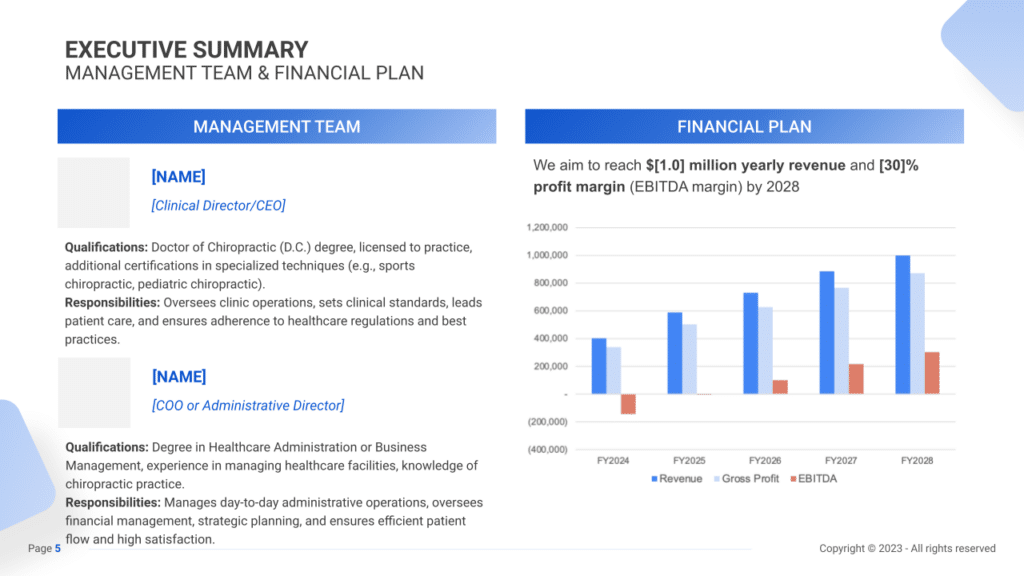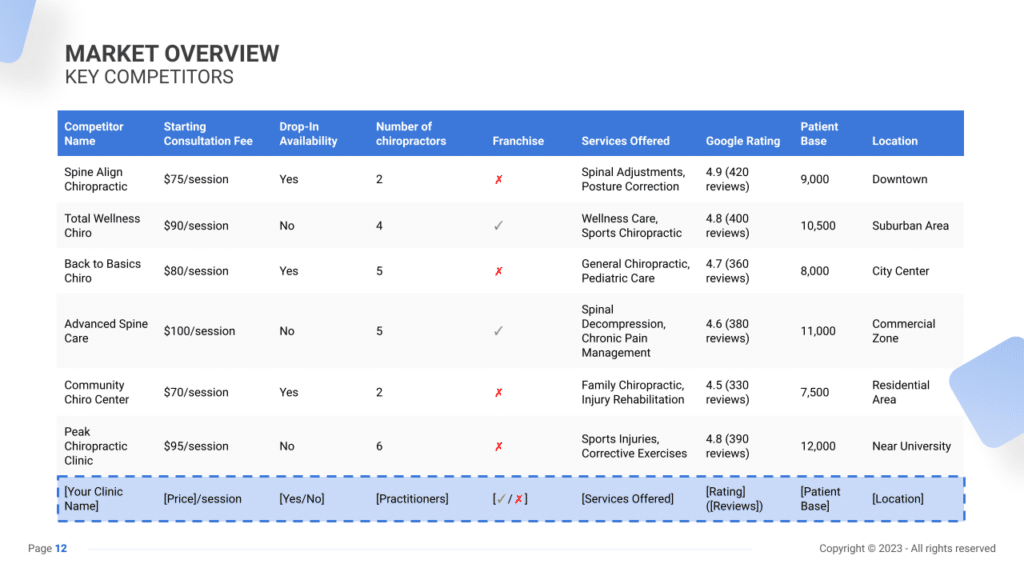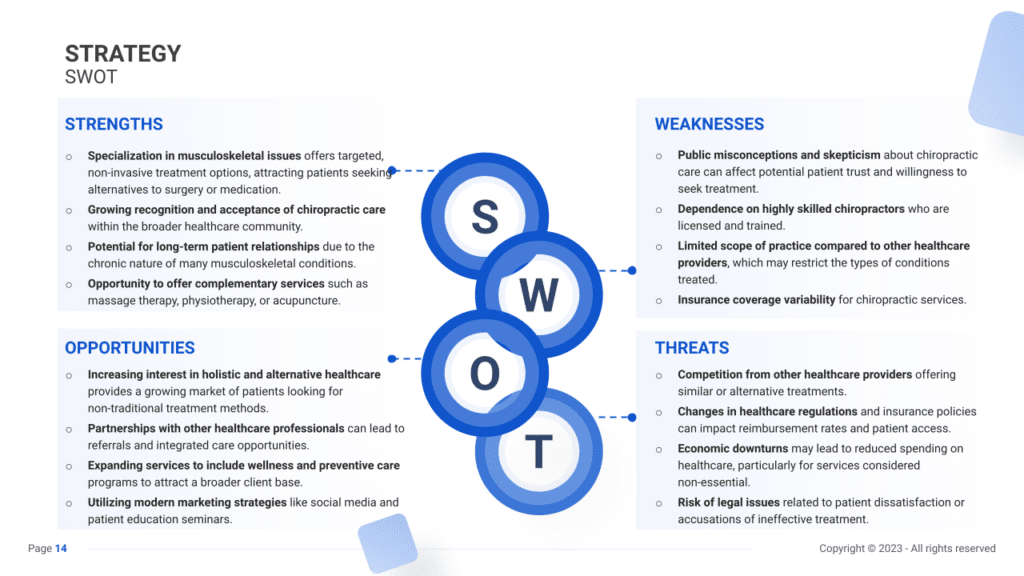Chiropractic Clinic Business Plan Template & PDF Example

Creating a comprehensive business plan is crucial for launching and running a successful chiropractic clinic. This plan serves as your roadmap, detailing your vision, operational strategies, and financial plan. It helps establish your chiropractic clinic’s identity, navigate the competitive market, and secure funding for growth.
This article not only breaks down the critical components of a chiropractic clinic business plan, but also provides an example of a business plan to help you craft your own.
Whether you’re an experienced entrepreneur or new to the healthcare industry, this guide, complete with a business plan example, lays the groundwork for turning your chiropractic clinic concept into reality. Let’s dive in!
The Plan
Our chiropractic clinic business plan is designed to cover all essential components needed for a comprehensive strategic framework. It elaborates on the clinic’s operational processes, marketing plans, market conditions, competitive landscape, management hierarchy, and financial forecasts.
- Executive Summary: Offers an overview of the Chiropractic Clinic’s business concept, emphasizing its specialized chiropractic services for musculoskeletal issues, market analysis highlighting the growing demand for alternative healthcare treatments, a well-qualified management team, and a financial plan aimed at achieving sustainability and growth.
- Business Overview: Provides detailed information on the chiropractic services offered and the operational model of the clinic:
- Clinic & Location: Describes the clinic’s design, state-of-the-art chiropractic equipment, patient amenities, and the strategic significance of its location for accessibility and patient convenience.
- Treatments & Prices: Lists the chiropractic treatments available, including spinal adjustments, therapeutic exercises, and specialized care for various patient needs, along with a transparent pricing model.
- Market Overview: Examines the chiropractic care industry landscape, identifying key competitors and differentiating factors of the Chiropractic Clinic:
- Key Stats: Discusses the industry’s size and growth trends, emphasizing the increasing interest in chiropractic services as part of a holistic healthcare approach.
- Key Trends: Highlights significant trends such as the integration of chiropractic care with other healthcare services, the adoption of advanced technology in patient assessments, and the growing focus on personalized care plans.
- Key Competitors: Analyzes the main competitors in the area, noting how the Chiropractic Clinic distinguishes itself through its comprehensive range of services, advanced treatment techniques, and patient-centered care approach.
- Strategy: Outlines the Chiropractic Clinic’s strategic plan for growth and patient attraction:
- SWOT: A detailed Strengths, Weaknesses, Opportunities, and Threats analysis, tailored to the Chiropractic Clinic’s context, to inform strategic planning.
- Marketing Plan: A comprehensive strategy for promoting the clinic’s services, including digital marketing, partnerships with healthcare providers, patient education seminars, and community health initiatives.
- Timeline: Sets key milestones and objectives from the clinic’s conceptualization through to its first year of operation, including critical phases like staff recruitment, service launch, and the initiation of marketing activities.
- Management: Provides information on the Chiropractic Clinic’s management team, detailing the roles, qualifications, and expertise of key personnel, emphasizing their capability to lead the clinic towards achieving its strategic goals.
- Financial Plan: Projects the Chiropractic Clinic’s 5-year financial performance, including detailed forecasts of revenue from various treatments, projected expenses, and profitability analysis to demonstrate the clinic’s potential for financial success and operational sustainability.

Executive Summary
The Executive Summary introduces your chiropractic clinic’s business plan, offering a concise overview of your clinic and its services. It should detail your market positioning, the range of chiropractic and wellness services you offer, its location, size, and an outline of day-to-day operations.
This section should also explore how your chiropractic clinic will integrate into the local health and wellness market, including the number of direct competitors within the area, identifying who they are, along with your clinic’s unique selling points that differentiate it from these competitors.
Furthermore, you should include information about the management and co-founding team, detailing their roles and contributions to the clinic’s success. Additionally, a summary of your financial projections, including revenue and profits over the next five years, should be presented here to provide a clear picture of your clinic’s financial plan.
Chiropractic Clinic Business Plan Executive Summary Example


Business Overview
A clear introduction is vital. Begin by elucidating your clinic’s name, location, and primary services. Your unique selling proposition (USP) should shine through here, delineating what distinguishes your clinic from others. Whether it’s a specialized treatment methodology, innovative technology implementation, or a holistic approach to patient care, your USP should resonate.
Example:
“SpineWell Chiropractic,” nestled in the heart of [City/Neighborhood], offers specialized care for spinal and musculoskeletal issues. Our clinic’s focus encompasses treating back pain, neck discomfort, joint ailments, and headaches, and promoting preventive spinal health. Notably, our clinic stands out for its comprehensive care model that integrates cutting-edge technology with a patient-centered approach, ensuring optimal recovery and well-being.
Market Overview
Detailing the local market landscape, including demand, trends, and competitive analysis, is crucial. Highlight the size and growth of the chiropractic services market, along with any notable shifts or emerging preferences. Emphasize how your clinic positions itself amidst competitors, underscoring what makes it a preferred choice for patients.
Example:
The chiropractic clinic industry in the United States is currently valued at an impressive $480 million, showcasing a remarkable +26.3% Compound Annual Growth Rate (CAGR) forecasted from 2023 to 2032. SpineWell Chiropractic, while competing with established local practices, distinguishes itself by not only delivering expert care but also leveraging advanced technology and a patient-centric approach, appealing to health-conscious individuals seeking comprehensive chiropractic solutions.
Management Team
Highlight the expertise and qualifications of your clinic’s key personnel. Showcase their credentials, experience, and contributions to the clinic’s success. Demonstrating a strong team fosters investor and partner confidence in your clinic’s capability to deliver exceptional care.
Example:
At SpineWell Chiropractic, Dr. Jane Doe, a Doctor of Chiropractic Medicine with over a decade of experience specializing in spinal health, leads our team. Supported by a dedicated staff of licensed chiropractors and healthcare professionals, our clinic boasts a wealth of expertise in musculoskeletal care, rehabilitation, and patient-centered treatments.
Financial Plan
Provide a concise summary of your clinic’s financial objectives and projections. Outline revenue targets, anticipated profit margins, and key strategies driving financial growth. This section offers a glimpse into the clinic’s financial trajectory and long-term sustainability.
Example:
SpineWell Chiropractic aims for a projected annual revenue of $1.0 million by 2028, accompanied by an ambitious 30% profit margin (EBITDA margin). Our financial strategy involves strategic marketing initiatives, community engagement programs, and prudent investment in advanced technology, positioning the clinic for substantial growth and recognition within the local healthcare landscape.
Business Overview
For a Chiropractic Clinic, the Business Overview section can be effectively divided into 2 main slides:
Clinic & Location
Begin by describing the clinic’s physical environment, focusing on its therapeutic and welcoming atmosphere, which aims to promote relaxation and healing. Mention the clinic’s location, highlighting its accessibility to patients, including proximity to residential areas, ease of parking, and availability of public transportation.
Also explain why this location is strategically chosen to attract your target patient demographic, considering factors like local health trends and the presence of complementary health services in the area.
Treatments & Prices
Detail the range of chiropractic treatments and wellness services offered, from spinal adjustments and manual therapies to complementary treatments such as massage therapy, physiotherapy, or acupuncture. Outline your pricing strategy, ensuring it reflects the value and quality of the healthcare services provided, and is competitive within the local market.
Highlight any special packages, membership plans, or loyalty programs that provide added value to your patients, encouraging long-term wellness plans, repeat visits, and patient loyalty.


Market Overview

Industry size & growth
In the Market Overview of your chiropractic clinic business plan, start by examining the size of the chiropractic care industry and its growth potential. This analysis is crucial for understanding the market’s scope and identifying expansion opportunities.
Key market trends
Proceed to discuss recent market trends, such as the increasing consumer interest in holistic health practices, the integration of chiropractic care with overall wellness, and the use of technology in chiropractic treatments. For example, highlight the demand for services that cater to specific health needs and concerns, alongside the rising popularity of clinics offering a holistic approach to health and wellness.
Competitive Landscape
A competitive analysis is not just a tool for gauging the position of your chiropractic clinic in the market and its key competitors; it’s also a fundamental component of your business plan. This analysis helps in identifying your chiropractic clinic’s unique selling points, essential for differentiating your business in a competitive market.
In addition, competitive analysis is integral in laying a solid foundation for your business plan. By examining various operational aspects of your competitors, you gain valuable information that ensures your business plan is robust, informed, and tailored to succeed in the current market environment.
Identifying Your Chiropractic Clinic’s Competitors
The initial step in comprehending your clinic’s market position involves identifying and evaluating competitors within the chiropractic and broader healthcare industry. Start by mapping out local chiropractic clinics, wellness centers, physical therapy facilities, and hospitals offering similar services. Consider alternative healthcare providers like acupuncture centers or massage therapy clinics, as they might cater to overlapping client needs.
Online resources such as Google Maps, healthcare directories, and patient review platforms like Healthgrades or Yelp can provide insights into competitor locations, services offered, patient satisfaction, and perceived strengths and weaknesses. For instance, positive reviews highlighting the personalized care at “Wellness Haven Chiropractic” signify a competitive strength worth noting.

Chiropractic Clinics’ Strategies
Analyzing the strategies of competitors in the chiropractic field involves multifaceted considerations:
- Services Offered: Evaluate the range of services provided by rival clinics. A clinic emphasizing sports injury rehabilitation might cater to a distinct clientele compared to one focusing on prenatal care and family wellness.
- Treatment Approaches: Consider different treatment modalities and philosophies adopted by competing clinics. For example, a clinic specializing in holistic chiropractic care might employ different techniques than a clinic emphasizing traditional spinal adjustments.
- Pricing Structure: Compare service fees and pricing models across various chiropractic clinics. Are your rates more aligned with “Affordable Spine Solutions” or positioned closer to higher-end clinics like “Elite Wellness Chiropractic”?
- Marketing and Patient Outreach: Examine how competitors market their services. Do they leverage digital marketing, community outreach, or educational seminars? Understanding their outreach strategies can inform your clinic’s marketing approach.
- Patient Experience: Assess the patient experience at rival clinics. Clinics like “Compassionate Care Chiropractic” may excel at providing a warm and welcoming environment, enhancing patient satisfaction.
- Technological Integration and Efficiency: Observe if competitors utilize advanced technology or innovative practices to enhance patient care or streamline administrative processes, such as electronic health records or telehealth services.
What’s Your Clinic’s Value Proposition?
Reflect on your chiropractic clinic’s distinctive value proposition. Perhaps your clinic specializes in a unique treatment approach, like incorporating yoga or nutrition counseling alongside chiropractic care. It could also be known for its exceptional patient education initiatives or specific expertise in treating certain conditions.
Identify gaps in the market through patient feedback and industry trends. For instance, an increasing demand for integrative chiropractic and mental health services might represent an untapped market opportunity if competitors are not addressing this need.
Consider your clinic’s location and patient demographics. A clinic situated in a corporate area might emphasize stress management and ergonomic assessments, while one in a family-oriented suburb might focus on pediatric chiropractic care and family wellness programs.
Strategy

SWOT
First, conduct a SWOT analysis for the chiropractic clinic, highlighting Strengths (such as experienced chiropractors and a comprehensive range of treatments), Weaknesses (including potential high operational costs or intense competition), Opportunities (for example, a growing public interest in alternative and complementary healthcare), and Threats (such as changes in healthcare regulations or economic downturns that may impact patients’ willingness to invest in non-essential health services).

Marketing Plan
Next, develop a marketing strategy that outlines how to attract and retain patients through targeted advertising, educational workshops, an engaging social media presence, and involvement in community health initiatives. Emphasize the importance of building trust and demonstrating the effectiveness of chiropractic care in improving quality of life.
Marketing Channels
Utilizing diverse marketing channels is essential to reaching and engaging with potential patients, building awareness, and driving foot traffic to the clinic.
Digital Marketing
- Website and SEO: Developing a user-friendly, informative website is paramount. Include sections highlighting services offered, patient testimonials, educational resources on chiropractic health, blog content, and information about the clinic’s practitioners. Optimize the website for local SEO to improve visibility in search engine results when potential patients look for chiropractic services in your area.
- Social Media: Leverage social media platforms like Facebook, Instagram, and LinkedIn to disseminate educational content, share patient success stories, and provide health tips. Engage with the audience through interactive posts, live Q&A sessions, and informative videos that showcase your expertise and commitment to patient well-being.
- Email Marketing: Build an email list by offering educational content or a newsletter subscription. Offer valuable content, health tips, and exclusive offers to subscribers. Regular newsletters can keep patients informed about clinic services, wellness events, and special promotions.
Local Outreach
- Community Engagement: Active community engagement through participation in health fairs, wellness workshops, and local events enables direct interaction with potential patients. Offering free spinal health screenings or consultations during these events can attract new patients and establish credibility within the community.
- Networking: Forge partnerships with local gyms, sports clubs, wellness centers, and healthcare professionals to create referral programs or joint promotional events.
- Educational Seminars: Hosting educational seminars or webinars on topics related to spinal health, posture correction, or stress management demonstrates expertise and fosters trust within the community.
Promotional Activities
- Special Offers: Strategic promotional activities can drive patient acquisition and encourage repeat visits. Launching special offers, such as ‘New Patient Wellness Packages’ or ‘Family Care Discounts,’ can entice new patients to schedule appointments and experience the clinic’s services.
- Referral Incentives: Implementing referral incentives for existing patients who refer new clients not only rewards loyalty but also amplifies patient acquisition efforts through word-of-mouth referrals.

Sales Channels
Implementing effective sales strategies within the clinic can maximize revenue and patient satisfaction.
In-Clinic Sales Techniques
- Education-Based Selling: Educating patients about the benefits of regular chiropractic care and additional wellness services during their visits can significantly impact sales. Train clinic staff to effectively communicate the value of these services and recommend appropriate treatment plans or add-on services to enhance the patient experience.
- Package Deals: Implementing package deals, such as ‘Wellness Assessment Packages’ or ‘Therapeutic Massage Add-ons’ to treatment sessions, can encourage patients to opt for additional services and increase the clinic’s revenue per visit.
Membership and Service Packages
- Membership Programs: Create membership plans offering discounted rates for monthly or quarterly chiropractic sessions, complementary therapies, or access to wellness workshops.
- Service Packages: Develop personalized treatment plans for specific conditions or demographics, such as ‘Senior Wellness Plans’ or ‘Athlete Recovery Programs’.
Strategy Timeline
Finally, create a detailed timeline that outlines critical milestones for the chiropractic clinic’s opening, marketing campaigns, patient base growth, and expansion objectives. Ensure the business moves forward with clear direction and purpose, setting both short-term and long-term goals to measure success and adapt strategies as needed.

Management
The management section focuses on the chiropractic clinic’s management and their direct roles in daily operations and strategic direction. This part is crucial for understanding who is responsible for making key decisions and driving the chiropractic clinic toward its financial and operational goals.
For your chiropractic clinic business plan, list the core team members, their specific responsibilities, and how their expertise supports the clinic’s mission.


Financial Plan
The Financial Plan section is a comprehensive analysis of the chiropractic clinic’s financial strategy, including projections for revenue, expenses, and profitability. It lays out the chiropractic clinic’s approach to securing funding, managing cash flow, and achieving breakeven.
This section typically includes detailed forecasts for the first 5 years of operation, highlighting expected revenue, operating costs, and capital expenditures.
For your chiropractic clinic business plan, provide a snapshot of your financial statement (profit and loss, balance sheet, cash flow statement), as well as your key assumptions (e.g. pricing strategies for memberships and services, etc.).
Make sure to cover here
_ Profit and Loss
_ Cash Flow Statement
_ Balance Sheet
_ Use of Funds









